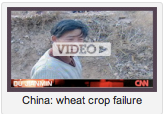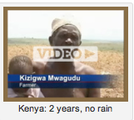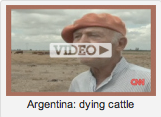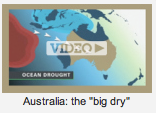A drought is a stealth disaster. There are no headline-grabbing satellite images of hurricane swirls, no “iReporter” videos of towns blown apart by tornados, no families perched on roofs desperate to escape rising floodwaters, no photographs of cities buried under snow. A drought has a different, much slower rhythm. The signs — a warming ocean, a shift in the wind — are subtle. But the effects can reverberate across continents, last for years, even decades, and spare nothing in its path.
Taking more of an address-the-symptom-never-mind-the-cause approach, theChinese bullied a few inches of snow to fall in Beijing by assaulting the heavens with a barrage of silver iodide-loaded cloud-seeding missiles. But beyond a brief uptick in the number of tourists at the Great Wall and a little frosty fun in the city, not much changed.
Meanwhile, the best plan to prepare for lean harvests remains the old biblical stand-by of stashing away surplus reserves from good harvests. But what do you do when global grain stores are running low and almost every “bread basket” farming region in the world is buckling under the same wilting weather report?
- Australia: Roughly 40% of the harvest, including $13.5 in exports sold mostly to Asia and the Middle-East, comes from the drought-plagued Murray Darling basin. Irrigated crops such as rice and grapes have been particularly had hit, but even native eucalyptus trees have taken a hit, with a staggering 80% stressed or dead. Water reserves are at just 16% of capacity. To make matters worse, algae are blooming and fish are dying in the warmth of shallower waters.
- The Middle-East: Australia’s bleak harvest is especially bad news here sincethe region is reeling under its own extreme drought. Annual rainfall totals in Jordan are down over 70%, while Israel experiencing its hottest, driest winter in 60 years. In Iraq, the marshlands of Garden of Eden and Marsh Arab fame are drying up. Water wars are heating up in comparatively moist Lebanon, exacerbated by out-of-date irrigation systems and a growing population. Everything is that much worse in the West Bank and Gaza with the Palestine Water Authority calling the situation “dangerous.”
- California: The recent decision by the federal government to turn off the spigot, at least temporarily, to irrigate the state’s Central Valley farms may have been inevitable, but it didn’t make the damage any easier to take: $2 billion in losses, 850,000 acres out of production, as many as 80,000 jobs lost. Although recent heavy rains helped, the problem is deeper. Or higher. The snowpack that feeds the streams that feed the Colorado river that supplies irrigation water is down by 40%. Ironically, the rains could make things worse, leading a burst of plant growth that will dry out just in time for fire season. In the meantime, sky-high alfalfa prices are threatening the entire dairy industry. Farmers, faced with losing money on every cow, are now sending them to the slaughterhouse instead of the milking barn, while horses, sometimes by the herd, are simply being abandoned by their owners. Elsewhere, Texas is toast and Florida’s looking pretty crispy.
- Kenya & Somalia: According to the World Food Program, 10 million people in Kenya are in urgent need of food aid. The impact of drought has been magnified by political violence and a fractured infrastructure. People are being forced to walk further and further – at great personal risk – simply to get water. It hasn’t rained in two years, the maize harvest is a complete bust and what little ground cover has managed to grow isn’t enough to support livestock. Just over the border in Somalia, the situation is just as dire. Families by the thousands are pouring into urban areas desperate for help. Meanwhile, some aid organizations have reportedly left the area due to fighting between Islamists and pro-government forces.
- Afghanistan: Drought has added yet another layer of complication to an already volatile situation. Taliban fighters in Pakistan routinely attack the Khyber Pass, which is used by the aid workers as well as military convoys to deliver supplies.
- Argentina: Rains have finally come to Argentina, but as in California, it may be too little, too late for many. The worst drought in a half-century has devastated this year’s corn crop, with yields down more than third from last year. An estimated 1.5 million cattle have been died. The economic tally? Over $5 billion.
- Northern India: The state of Uttarakhand is almost entirely dependent on rainfall and snow melt for farming and lately there hasn’t been much. Warmer temperatures has also caused mustard, a key crop, to flower prematurely, reducing yields.
- China: A massive 240 million-acre drought, the worst in 50 years, has left an estimated 4.4 million people and 2 million livestock literally high and dry. Rainfall in some areas is less than 10% of normal totals, threatening half the wheat crop. And due to the global recession, factories in the cities have shut down, leaving an estimated 20 million migrant farm workers with nowhere else to go. Ironically, the water shortage may have been exacerbated by China’s extensive reservoir system, which has diverted water from underground aquifers and increased surface evaporation.













